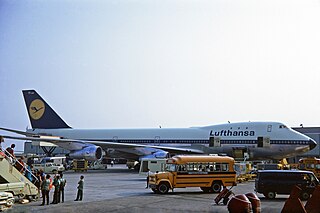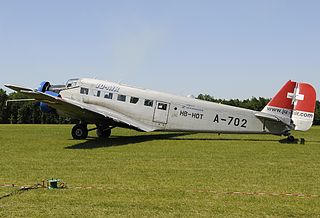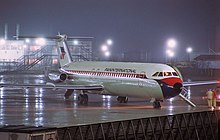The Societé anonyme belge d'Exploitation de la Navigation aérienne, better known by the acronym Sabena or SABENA, was the national airline of Belgium from 1923 to 2001, with its base at Brussels Airport. After its bankruptcy in 2001, SN Brussels Airlines was formed through a takeover of former subsidiary Delta Air Transport and took over part of Sabena's assets in February 2002. SN Brussels Airlines merged with Virgin Express in 2007 to form Brussels Airlines. The airline's corporate headquarters were located in the Sabena House on the grounds of Brussels Airport in Zaventem.

The BAC One-Eleven is an early jet airliner produced by the British Aircraft Corporation (BAC). Originally conceived by Hunting Aircraft as a 30-seat jet, before its merger into BAC in 1960, it was launched as an 80-seat airliner with a British United Airways (BUA) order on 9 May 1961. The prototype conducted its maiden flight on 20 August 1963, and it was first delivered to BUA on 22 January 1965. The 119-seat, stretched 500 series was introduced in 1967. Total production amounted to 244 until 1982 in the United Kingdom and between 1982 and 1989 in Romania where nine Rombac One-Elevens were licence-built by Romaero.

United Airlines Flight 232 was a regularly scheduled United Airlines flight from Stapleton International Airport in Denver to O'Hare International Airport in Chicago, continuing to Philadelphia International Airport. On July 19, 1989, the DC-10 serving the flight crash-landed at Sioux Gateway Airport in Sioux City, Iowa, after suffering a catastrophic failure of its tail-mounted engine due to an unnoticed manufacturing defect in the engine's fan disk, which resulted in the loss of many flight controls. Of the 296 passengers and crew on board, 112 died during the accident, while 184 people survived. 13 of the passengers were uninjured. It was the deadliest single-aircraft accident in the history of United Airlines.

Lufthansa Flight 540 was a scheduled commercial flight for Lufthansa, serving the Frankfurt–Nairobi–Johannesburg route.
Aviateca S.A. branded Avianca Guatemala is a regional airline headquartered in Guatemala City. Aviateca was under government ownership and remained so until 1989 when it joined the Grupo TACA alliance of Central America and was privatized. It was fully integrated into TACA, operating under the TACA Regional banner, which later merged with Avianca.
Spantax S.A. was a Spanish leisure airline headquartered in Madrid that operated from 6 October 1959 to 29 March 1988. Spantax was one of the first Spanish airlines to operate tourist charter flights between European and North American cities and popular Spanish holiday destinations and was considered a major force in developing 20th-century mass tourism in Spain. Its popularity and image faded from the 1970s onward when a series of crashes and incidents revealed safety deficits, which, combined with rising fuel costs and increasing competition, resulted in the company facing severe financial difficulties that led to its demise in 1988.

In aviation, a water landing is, in the broadest sense, an aircraft landing on a body of water. Seaplanes, such as floatplanes and flying boats, land on water as a normal operation. Ditching is a controlled emergency landing on the water surface in an aircraft not designed for the purpose, a very rare occurrence. Controlled flight into the surface and uncontrolled flight ending in a body of water are generally not considered water landings or ditching.

One-Two-Go Airlines Flight 269 (OG269) was a scheduled domestic passenger flight from Bangkok to Phuket, Thailand. On 16 September 2007, about 15:41 ICT, the McDonnell Douglas MD-82 operating the flight crashed into an embankment beside runway 27 at Phuket International Airport (HKT) bursting into flames upon impact during an attempted go-around after an aborted landing, killing 90 of the 130 people on board. It is the third deadliest aviation incident to occur in Thailand.

EAS Airlines Flight 4226 was a scheduled domestic passenger flight from Kano to Lagos, Nigeria. On 4 May 2002, the aircraft serving the route, a BAC One-Eleven 525FT with 69 passengers and 8 crew members on board, crashed into Gwammaja Quarters, a densely-populated residential area located approximately three kilometres from the airport, and burst into flames, resulting in the deaths of 66 passengers and 7 crew. In addition, at least 30 civilians on the ground were killed. With a total of 103 fatalities, Flight 4226 is the deadliest aviation accident involving a BAC One-Eleven.
Air France has been in operation since 1933. Its aircraft have been involved in a number of major accidents and incidents. The deadliest accident of the airline occurred on June 1, 2009, when Air France Flight 447, an Airbus A330-203, flying from Rio de Janeiro to Paris crashed into the Atlantic Ocean with 228 fatalities. A selected list of the most noteworthy of these events is given below.

Paninternational was a West German leisure airline headquartered in Munich with bases at Munich-Riem Airport and Düsseldorf Airport.

On 4 August 2018, a Junkers Ju 52 passenger aircraft operated by Ju-Air crashed near Piz Segnas, Switzerland, while en route from Locarno to Dübendorf. All 20 people on board were killed.

Elisabeth Friske was a West German commercial airline pilot. She was the first female commercial airline pilot in West Germany, and one of the first women to fly commercially anywhere in the Western Hemisphere.









